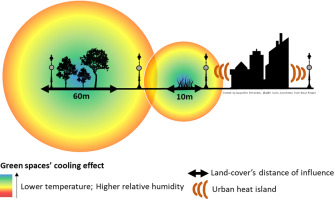当前位置:
X-MOL 学术
›
Sci. Total Environ.
›
论文详情
Our official English website, www.x-mol.net, welcomes your
feedback! (Note: you will need to create a separate account there.)
Using green to cool the grey: Modelling the cooling effect of green spaces with a high spatial resolution.
Science of the Total Environment ( IF 8.2 ) Pub Date : 2020-03-25 , DOI: 10.1016/j.scitotenv.2020.138182 Filipa Grilo 1 , Pedro Pinho 1 , Cristiana Aleixo 1 , Cristina Catita 2 , Patrícia Silva 3 , Nuno Lopes 3 , Catarina Freitas 3 , Margarida Santos-Reis 1 , Timon McPhearson 4 , Cristina Branquinho 1
Science of the Total Environment ( IF 8.2 ) Pub Date : 2020-03-25 , DOI: 10.1016/j.scitotenv.2020.138182 Filipa Grilo 1 , Pedro Pinho 1 , Cristiana Aleixo 1 , Cristina Catita 2 , Patrícia Silva 3 , Nuno Lopes 3 , Catarina Freitas 3 , Margarida Santos-Reis 1 , Timon McPhearson 4 , Cristina Branquinho 1
Affiliation

|
The urban heat island effect creates warmer and drier conditions in urban areas than in their surrounding rural areas. This effect is predicted to be exacerbated in the future, under a climate change scenario. One way to mitigate this effect is to use the urban green infrastructure as a way to promote the cooling island effect. In this study we aimed to model, with a high spatial resolution, how Mediterranean urban parks can be maximized to be used as cooling islands, by answering the following questions: i) which factors influence the cooling effect and when?; ii) what type of green spaces contributes the most to the cooling effect?; iii) what is the cooling distance of influence? To answer these questions we established a sampling design where temperature and relative humidity were measured in different seasons, in locations with contrasting characteristics of green and grey cover. We were able to model the effect of green and grey spaces in the cooling island effect and build high spatial resolution predicting maps for temperature and relative humidity. Our study showed that even green spaces with reduced areas can regulate microclimate, alleviating temperature by 1-3 °C and increasing moisture by 2-8%, on average. Green spaces with a higher density of trees were more efficient in delivering the cooling effect. The morphology, aspect and level of exposure of grey surfaces to the solar radiation were also important features included in the models. Green spaces influenced temperature and relative humidity up to 60 m away from the parks' limits, whereas grey areas influenced in a much lesser range, from 5 m up to 10 m. These models can now be used by citizens and stakeholders for green spaces management and human well-being impact assessment.
中文翻译:

使用绿色冷却灰色:以高空间分辨率对绿色空间的冷却效果进行建模。
与城市周围的农村地区相比,城市热岛效应在城市地区创造了更温暖,更干燥的条件。在气候变化的情况下,预计这种影响将在未来加剧。减轻这种影响的一种方法是利用城市绿色基础设施作为促进冷却岛效应的一种方法。在这项研究中,我们旨在通过回答以下问题,以高空间分辨率对如何最大程度地利用地中海城市公园作为降温岛进行建模:i)哪些因素影响降温效果?何时?ii)哪种类型的绿色空间对制冷效果的贡献最大?iii)影响的冷却距离是多少?为了回答这些问题,我们建立了一个采样设计,在不同季节测量温度和相对湿度,在具有绿色和灰色封面对比特征的位置。我们能够对冷却岛效应中绿色和灰色空间的影响进行建模,并建立高空间分辨率的温度和相对湿度预测图。我们的研究表明,即使是面积减少的绿色空间,也可以调节微气候,平均降低1-3°C的温度,并使水分增加2-8%。树木密度较高的绿色空间在提供冷却效果方面更为有效。灰色表面暴露在太阳辐射下的形态,纵横比和水平也是模型中包含的重要特征。绿地影响距公园范围最远60 m的温度和相对湿度,而灰色区域的影响范围从5 m到10 m小得多。
更新日期:2020-03-26
中文翻译:

使用绿色冷却灰色:以高空间分辨率对绿色空间的冷却效果进行建模。
与城市周围的农村地区相比,城市热岛效应在城市地区创造了更温暖,更干燥的条件。在气候变化的情况下,预计这种影响将在未来加剧。减轻这种影响的一种方法是利用城市绿色基础设施作为促进冷却岛效应的一种方法。在这项研究中,我们旨在通过回答以下问题,以高空间分辨率对如何最大程度地利用地中海城市公园作为降温岛进行建模:i)哪些因素影响降温效果?何时?ii)哪种类型的绿色空间对制冷效果的贡献最大?iii)影响的冷却距离是多少?为了回答这些问题,我们建立了一个采样设计,在不同季节测量温度和相对湿度,在具有绿色和灰色封面对比特征的位置。我们能够对冷却岛效应中绿色和灰色空间的影响进行建模,并建立高空间分辨率的温度和相对湿度预测图。我们的研究表明,即使是面积减少的绿色空间,也可以调节微气候,平均降低1-3°C的温度,并使水分增加2-8%。树木密度较高的绿色空间在提供冷却效果方面更为有效。灰色表面暴露在太阳辐射下的形态,纵横比和水平也是模型中包含的重要特征。绿地影响距公园范围最远60 m的温度和相对湿度,而灰色区域的影响范围从5 m到10 m小得多。











































 京公网安备 11010802027423号
京公网安备 11010802027423号